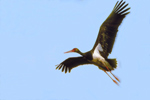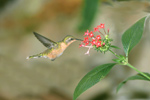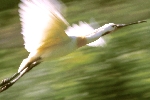|
|
|

|
|
|
|
The
Flight Photo
|
|
The best technique
to do photos of birds in flight and
|
|
animals in
movement.
|
|
|
|
Text and photos by Ernesto Francini
|
|
|
|
|

|
|
Black stork in take-off (Ciconia nigra) 1/1000 di sec.
|
|
|
|
|
To
effect a good photo of the animals in movement it is necessary to have a good
personal knowledge of the photographic technique and of the used
devices.
Exercise
and practice are then of fundamental importance and my personal suggestion,
to become specialist in this particular technique, it is first of all to
practice in continuation to handle our apparatuses quickly (without to
expose obligatorily the photographic film).
Only
so the photographer can acquire the correct reflexes and the necessary
rapidity of action.
The
birds and the animals in movement must be framed and followed in
continuation, with the camera, leaving the time to the autofocus electronic
system “to hook” the movement and to calculate the speed of the subject.
With the autofocus selector set on C (continuous) or
AI servo, according to the type of camera used, the focus prediction system
will enter automatically in operation, and in base to the speed
and direction of the subject, it will be able to
anticipate the exact point of lens focus when
we will press the shutter release button.
It's
advisable to press the shutter button only some second after to have framed
the subject, when the same will appear clearly in focus in the viewfinder,
a sudden release without to observe such rule will produce in the greatest
part of the cases a lost photo.
The
actual systems in commerce also work very good with quick subjects. With a
300 f.2.8 lens, the modern cameras are able to focalize a subject that is
moving to the speed of 50 Km/h, in the photographer direction, up to reach
the minimum distance of 8 mt. from the camera.
Obviously
the possibility of a quick and precise reading of the system will be also
function of the type of used lens, in particular from its brightness.
More
high will be the lens brightness better will be the promptness of the
autofocus.
The
lenses that lend better the rapidity demands of the naturalist photographer
are those with ultrasonic motor incorporated. Some time ago only Canon
prerogative, currently also produced from others important manufacturers.
Generally, for the birds in flight, with background a
uniform sky, it is preferable to put in action all sensors contemporarily,
if the camera foresees a multiple sensors autofocus system, since in this
case a fast subject that is moving on an uniform background can be better
followed by a more wide focus area.
|
|
If
the background is not uniform but introduces trees or other elements of the
environment, next to the subject, that could deceive the sensors, it is
preferable to use an unique sensor, normally the central, that is the most
sensitive, and constantly to follow the subject with this sensor only; we
will have so, in this manner, more possibilities to get a better
focalization.
We
don't have to forget that between all the focus sensors of which the camera
is endowed,
normally,
one of them has more sensibilities in comparison to the others, usually the
central sensor. It is more quick to answer, so in the case of a very fast
subject, which is near at the position in which I am, I always have the
preference to use the only central sensor.
Normally
it is preferable to select the Shutter-speed Priority Program and the
exposure times must be selected in consideration of the type of result that
we want to get.
This
is the ideal method to stop the movement, in the field of moving subjects,
or to obtain an effect of partial movement (controlled movement).
In
the naturalistic photo of birds in flight, the responsibility of a not
perfect photo, from the point of view of the sharpness, it is often
attributed to the autofocus system, while nobody is being worried to verify
with attention if the used time is suitable or less for the effect that we
intend to have, or if the camera is kept firmly between the hands from the
photographer or by the support.
There
are two possibilities to follow:
1) to
freeze the movement.
2) to
create an effect of partial movement.
If we want to freeze the movement of the subject it is
necessary to select quick times on the camera.
The
subject must be framed and constantly followed with the camera.
The
shooting to follow will annul the motion of the subject so it will allow us
to use less quick times instead of those that would be necessary in the
case the camera was not movable (otherwise impossible to get the correct
exposure in the common naturalistic photography with the only solar light).
Personally,
in this case, in the photo of birds in flight, of middle or great sizes,
for safety reasons, I never go down under 1/1000 of sec., although in some
situations, with big birds having a slow pulsation of wings (storks, grey
herons and so on) could be enough also 1/500 of sec.
|
|
|
|

|
|
Saker (Falco cherrug) 1/1000 di sec.
|
|
|
|
|
For
birds of small dimensions as the sparrows, the times have to be necessarily
more short, in every case it is advisable to never go down under 1/2000 of
sec.
If
the subject is near to the photographer, within the capacity of our flash,
a valid help can also to come from the use of such device.
Regulating manually the power of the issued lightning
we will determine the duration of the same lightning accordingly, and
therefore we will be able to stop the movement of a subject near to us.
More
lower will be adjusted the power of the flash, more quick will be the
lightning time of which we will take advantage. Obviously this will go to
reduce the maximum distance to shoot a subject, since reducing the times of
the lightning will also means to decrease the capacity of the flash to send
distant the light.
In
the most recent flashes the function FP also exists, and it's more
comfortable to use, it allows us to synchronise every shutter speed of the
camera, between 1/250 to 1/8000 of sec., directly with the flash emission,
in order to have a quick time exposure as we require to freeze the
movement. Naturally also here reducing the shutter time we will reduce the
capacity of the flash.
|
|
|
|

|
|
Purple-collared woodstar hummingbird (Myrtis fanny) 1/2000
di sec.
|
|
|
|
|
If we want to create an effect of partial movement the
selected time will have to be more slow necessarily.
Such
value will depend on the type of effect that we will want to get.
If we
for instance want to shoot a bird in flight and to achieve an effect of
movement on the wings we will have to choose necessarily a lower time of
the time used to freeze the wings movements.
Personally
I follow this rule:
1) I
establish the time necessary to freeze the movement of the wings.
2) I
divide such time for 4 and I get so the time that I will have to set on the
camera to create
an effect of partial
movement.
If
the wing pulsation's for instance requires a time of 1/1000 of sec., to
freeze the movement, the selected time for an effect of partial movement
will be 1/250 of sec. (1000:4).
The
selected time will create so the desired effect on the wings, letting see
the movement effect, but it will also must to be enough to stop the body of
the bird, perfectly.
|
|
|
|

|
|
Little owl in flight (Athene noctua) 1/250 di sec.
|
|
|
|
|
In the case we wanted to achieve a panoramic effect
that gives impression of movement to the whole scene the technique to be
used it is surely the " panning ".
The
" panning " is a panoramic shooting of the subject in movement,
correctly exposed and focused, while the background slips away as a strip
not in focus, increasing in this way the sensation of movement.
The
" panning " must be performed following with viewfinder the
subject and constantly holding it in focus, contemporarily pressing the
shutter button to achieve a continuous shooting and in the same time to do
a rotatory movement of the arms and camera.
The
rotatory movement will have to be uniform and it also must continue after
the last shot, without to be interrupted brusquely.
It's
necessary that our legs are kept well firm on the ground and the rotation
happens only through the torsion of head and bust in the more stable mode
possible.
It's
preferable to select a shooting point that allows us to follow the subject
with an arc of view the amplest possible, in this way we will have more
time at our disposition to shoot and we will be able to achieve more shots
in a single sequence.
The
time to set on the camera will depend from the speed with which the subject
is moving.
Personally
I follow this rule:
1) I
check speed and distance of the subject.
2) I
establish the time necessary to freeze the movement of the subject.
3) I
divide such time for 8 and I get so the time that I will have to set on the
camera to obtain
the " panning
"effect.
If a
bird in flight, for instance, requires a time of 1/1000 of sec., to freeze
its movement, the selected time for the " panning " will be 1/125
of sec. (1000:8).
|
|
|
|

|
|
Spoonbill in take-off (Platalea leucorodia) 1/125 di sec.
|
|
|
|
|